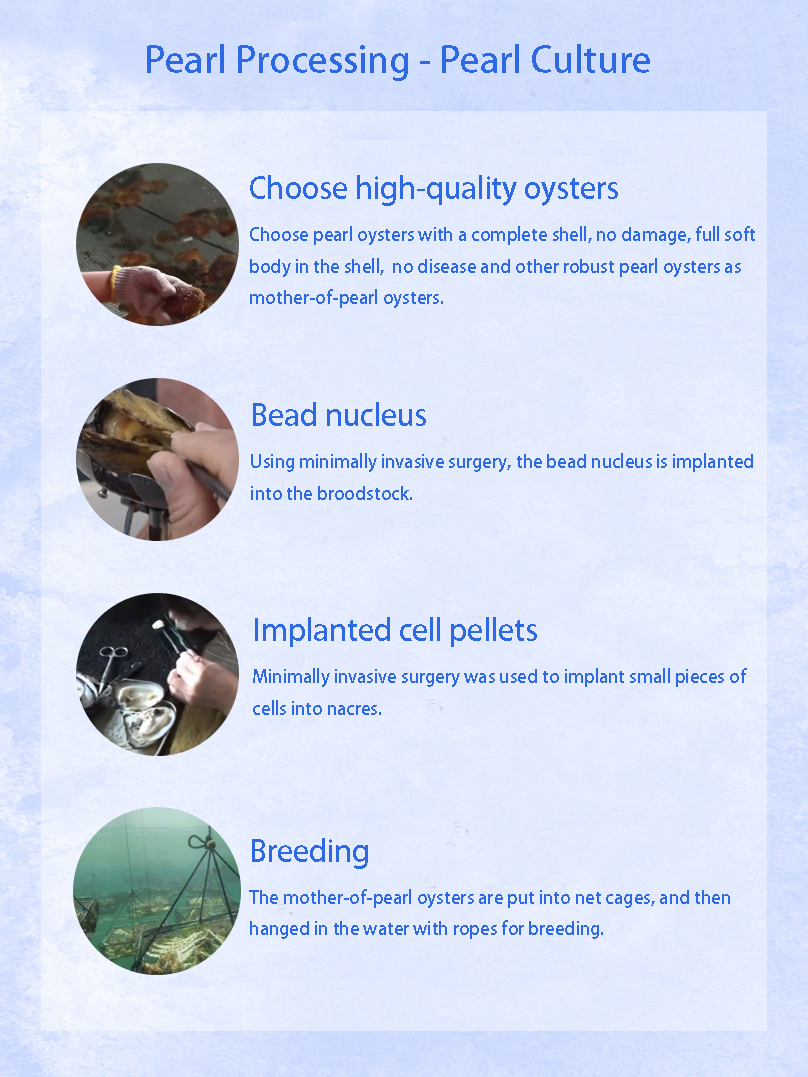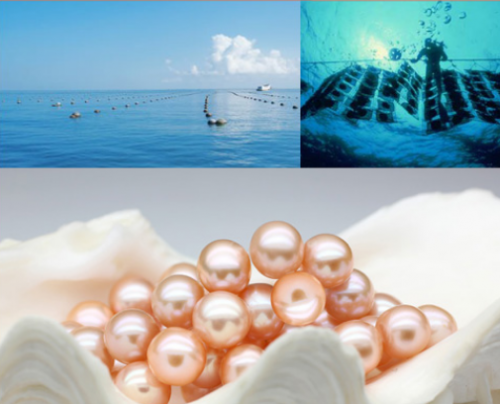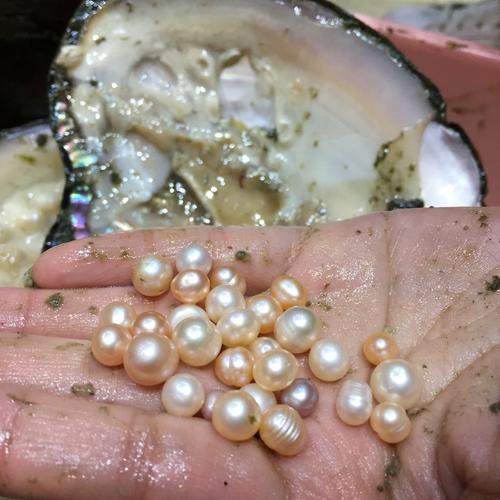Pearl Processing - Pearl Culture
Pearl Processing - Pearl Culture
- Choose high-quality oysters
Choose pearl oysters with a complete shell, no damage, full soft body in the shell, no disease and other robust pearl oysters as mother-of-pearl oysters. - Bead nucleus
Using minimally invasive surgery, the bead nucleus is implanted into the broodstock - Implanted cell pellets
Minimally invasive surgery was used to implant small pieces of cells into nacres. - Breeding
The mother-of-pearl oysters are put into net cages, and then hanged in the water with ropes for breeding.

Pearl culture is based on the physiological function of pearl oysters that can secrete nacre to form pearls, implant small pieces of cells in the body of pearl oysters, and cultivate pearls after a certain period of time.

How to cultivate pearls ?
1. Cultivation of nucleated pearls: first use thick shells as raw materials to make spherical bead cores, then select juvenile pearl oysters that have been raised for 1 to 2 years, cut out their mantle, and then insert the bead core into an adult pearl oyster. A small piece of the outer epidermis of the mantle is placed in the connective tissue of the mantle at the same time, so that one side of the epidermal cells is close to the surface of the bead nucleus. , Over time, large and round artificial nucleated pearls are formed.
2. Cultured seedless pearls: As long as the prepared mantle epidermis is transplanted into the connective tissue of the mantle of another mollusk with a tool, after the cells proliferate, a pearl sac will be formed, and with the continuous secretion of nacre, cultured into seedless pearls.

3. Cultured pearls with shells: foreign objects of a certain shape are inserted between the shell and the mantle, and nacre is secreted around the foreign objects, which are attached to the inner wall of the shell to form so-called Buddha pearls and semi-circular beads. and so on.
The process of cultured pearls can be roughly divided into the following three stages. Now we take the artificial culture of mussels as an example for a brief description.
1. (1) Preparation stage. First of all, pearl-producing animals must be cultivated and selected. Due to the different environmental requirements of various pearl-producing animals, excellent varieties that are suitable for the environmental conditions of the region must be selected. From the point of view of freshwater aquaculture, the pearls produced by the spinnaker mussel are of high quality, and the seawater cultured pearls are mainly marshmallows, white butterfly shells, black butterfly shells, etc. In the farm, because a large number of pearl-producing animals are required, they are generally the varieties required for artificial cultivation. From larvae to ready-to-use individuals, it generally takes 2-3 years to cultivate, and robust, disease-free and large individuals must be selected. In young and middle-aged mussels, this directly affects the secretion function, individual viability and pearl quality of small pieces of cells collected by nlJ. The pearl-producing mussels can be divided into sliced mussels and inserted mussels. The sliced mussels are specially cut out of the mantle to make small pieces of cells; The mussels are younger than the mussels.
2. (2) Bead breeding operation stage. There are the following situations.
① Nurturing seedless pearls: The surgical operation is divided into two steps: filming and inserting. Production is to remove the outer epidermis of the edge membrane of the mantle of the mussel to make small cell pieces, cut them into 5mm square pieces after processing and repair, wash the front side of the small cell pieces, and spread them on a glass plate facing upwards. Add maintenance fluid for later use. Insertion is to insert the prepared small pieces of cells into the connective tissue of the mantle of the mussels, so that the small pieces of connective tissue and the connective tissue of the mantle are healed, and the outer epidermal cells form pearl sacs, which secrete nacre to form pearls. .
② Nucleated pearls: The difference from nurturing non-nucleated pearls lies in the preparation of bead cores. The bead core of freshwater cultured pearls can be made of glass, agate, marble and other materials, but it is best to use shells as the bead core. The production method of the bead core is generally first sawed into strips, then cut into cubes or cylinders, sandwiched between two grinding wheels with concentric grooves and ground into spherical bodies, which are rough embryos, and then bleached, polished, washed. Use after cleaning and disinfection. After the bead nuclei are prepared, the process of inserting the nucleus and sending the cell small pieces is carried out. The small cell pieces used in the nucleated pearls only need to be 2mm square, and they are sent to the person at the same time as the bead nucleus, or the nucleus is inserted first and then the slice is sent, or the slice is sent first and then the nucleus is inserted. and so on. But no matter which method, the small cell pieces must be thin and uniform. If the small cell piece is large and thick, it will form a nucleated bead with a tail. The front of the small piece must be close to the nucleus of the bead in a mussel body. Generally, 8-10 large nuclei are inserted. , the number of small nuclei can reach 20, and the number of nuclei is closely related to the size of nuclei, the physique of mussels, and the season of nucleation. Nucleated beads can also be inserted into mussels with nucleated beads. Generally, if the mantle of the mussels after nucleation has not been fully utilized, small pieces of cells without nucleated beads can be inserted. In addition, if the mussels undergo nuclear spitting after nucleation, small pieces of mussels without nucleated beads can also be inserted.
The best season for inserting pearls is in late spring and early summer, because summer and autumn are the peak seasons for mussels to secrete nacre.
3. (3) Breeding of mussels. Whether it is non-nucleated beads or nucleated beads, they must be put back to the bead farm for rearing. The environment of the bead farm has a lot to do with the growth rate of pearls. Generally speaking, the water flow is smooth and the oxygen content is rich. , The environment where the bait (plankton) is prosperous, the water temperature needs to be between 18°C and 25°C and the pH is around 7-7.5 is the most suitable. In this environment, the metabolism of mussels is strong, the ability to secrete nacre is strong, the wound heals quickly, and the small pieces of cells are not easy to die. In a suitable environment, pearl sacs can be formed within 10~20 days of inserting, and nacres will begin to secrete within 25~30 days.
The mussels are raised in the bead farm by hanging, caged or ground transplanting methods. In the feeding process, it must be properly managed to prevent mussel disease and other harmful events.
For the age of pearl culture, it is appropriate to cultivate non-nucleated pearls for 2 to 3 years. Its growth is most significant in the second and third years, and the growth rate will decrease in the fourth year. Pearls can be harvested in winter. The cultivation period of nucleated pearls is slightly shorter than that of non-nucleated pearls. The nuclei with a diameter of 4~5mm can be harvested after cultivating for 1.5~2 years, but the large nuclei above 6mm need to be cultivated for 2~3 years or more.


 WhatsApp Code
WhatsApp Code